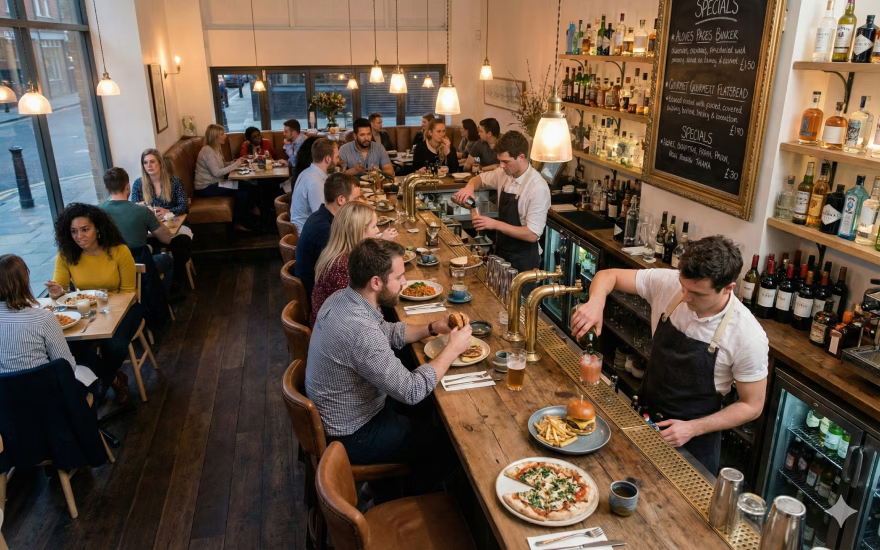How Gen Z Food Preferences Are Reshaping the Restaurant Industry & What Operators Can Do About It

Generation Z is fast becoming a dominant influence in the restaurant space — not only as diners but also as employees. Gen Z makes up over 40% of global consumers and accounts for a growing share of the U.S. workforce. Their expectations are turning traditional restaurant models on their head.
According to a report by EAB, Gen Z customers favor sustainable, plant-forward meals, culturally authentic cuisine, and tech-integrated service experiences. These values are showing up as deal-breakers — meaning, if a restaurant doesn’t meet these standards, Gen Z will spend elsewhere.
For restaurant operators, this generational shift means that aligning with Gen Z’s values isn’t just about image — it’s a key business strategy to drive revenue, reduce turnover, and remain relevant in a highly competitive market.
How Is Gen Z Shaping Restaurant Menus?
Gen Z isn’t just interested in what’s on the menu — they care how it got there. This group is actively steering the industry toward plant-based, ethically sourced, and globally inspired dishes.
What Ingredients and Food Experiences Appeal Most?
- Plant-Based & Sustainable Items: Roughly 8% of Gen Z consumers identify as vegetarian or vegan, a figure that continues to rise annually, according to EAB. Even meat-eating Gen Z customers expect restaurants to offer quality vegetarian options by default.
- Sustainable and Ethically Sourced: Gen Z scrutinizes ingredient sourcing. Restaurants that adopt traceability and fair trade practices are likely to earn their loyalty.
- Culturally Authentic Dishes: Gen Z highly values authenticity. They flock to restaurants where chefs embrace their cultural roots and tell a story through food.
Operators should consider integrating menu storytelling — highlighting not just ingredients, but also the inspiration and ethos behind the dishes.
How Does Convenience Influence Gen Z’s Dining Habits?
Short on time and always connected, Gen Z embraces food that fits seamlessly into their lifestyle. Snacking culture, quick meals, and meal kits are on the rise.
- Grab-and-Go & App-Based Ordering: Gen Z prefers restaurants that offer online ordering, curbside pickup, and mobile-friendly interfaces.
- Microwave Innovation: Surprisingly, Gen Z consumes 30% more frozen and ready-to-heat meals than Millennials, highlighting their demand for convenience that still feels fresh and healthy.
To meet staffing demands and keep up with these convenience-driven habits, restaurants need to become more operationally agile. Intelligent labor scheduling tools, like Push Operations, help optimize workforce management — ensuring teams are staffed appropriately to meet peak times without overspending on labor.
Why Is Technology Non-Negotiable for Gen Z Restaurant Customers?
Tech isn’t a luxury for Gen Z — it’s an expectation. From ordering to payment to loyalty programs, tech-integrated dining is table stakes.
- Mobile-First Service: Gen Z expects menus accessible via QR codes, digital payments, and loyalty programs through apps — all without friction.
- Instagrammable Moments: Share-worthy decor and culinary visuals drive dining decisions. For Gen Z, food is both fuel and content.
- Digital Reviews & Engagement: Online reviews highly influence their perception. Restaurants that respond quickly and engage authentically online build trust.
Integrating mobile workforce technology — like Push’s all-in-one scheduling and communication tool — can ensure staff are prepared to meet these customer demands efficiently, while creating a seamless service experience.
How Can Restaurants Tap Into Gen Z’s Sustainability Values?
Sustainability is an essential filter through which Gen Z views brands. Restaurants that ignore this may find themselves left off the menu.
Key Drivers of Sustainable Dining Expectations
- Eco-Friendly Packaging: Gen Z seeks biodegradable and responsibly made packaging, especially in takeout and delivery.
- Zero-Waste Kitchens: They value efforts to minimize food waste, including creative reuse of ingredients.
- Carbon Transparency: Brands that publicly share their efforts to reduce environmental impact gain favor.
Operational efficiency matters here. Tools like Push’s labor management platform enable restaurants to reduce labor waste, better match staffing to demand, and free up resources for sustainability initiatives.
What Does the Gen Z Workforce Expect from Restaurant Employers?
As employees, Gen Z brings their consumer values into the back of house. They want more than a paycheck — they want purpose, flexibility, and technology that simplifies their workday.
- Flexible Scheduling: Staff want control over their hours and the ability to manage schedules via mobile apps.
- Cultural Fit: Gen Z workers prefer employers that reflect their social and environmental values.
- Tech-Enabled HR: From digital onboarding to real-time communication, Gen Z expects workplace tech to be as intuitive as their personal devices.
Push’s user-friendly tools for onboarding, scheduling, and HR communication are designed with younger workers in mind. Features like self-service shift swaps and mobile onboarding streamline operations while improving staff satisfaction.
How Can Technology Improve Gen Z Staff Retention?
- Mobile Scheduling: Employees can view and manage their schedules, request time off, and swap shifts easily.
- Task Automation: Reducing administrative overhead through automation frees managers to focus on staff engagement.
- Performance Recognition: Supporting feedback tools and recognition systems can help motivate Gen Z teams.
Restaurants using digital workforce solutions see stronger retention and more consistent service quality — essential advantages in a high-turnover industry.
How Should Branding and In-Restaurant Experiences Reflect Gen Z Values?
To win Gen Z’s loyalty, restaurants must feel more like lifestyle brands. It’s not just about food — it’s about a vibe, a story, and a mission.
- Aesthetic Appeal: Stylish, modern interiors paired with digital engagement tools drive Gen Z traffic.
- Experiential Design: Interactive elements — like open kitchens or digital walls — offer the immersive experience Gen Z craves.
- Storytelling: Restaurants that weave purpose into their décor, print materials, and social media stand out.
Restaurants should evaluate how their brand looks and feels, both online and in-store — and whether it invites Gen Z to engage and share.
How Can Restaurant Operators Adapt Without a Total Overhaul?
It’s not about changing everything overnight. Operators can make incremental changes that offer tangible returns.
- Test Menu Rotations: Introduce global flavors or plant-based items as limited-time offers to evaluate performance.
- Optimize Hours and Labor: Use tools like Push Reporting and Analytics to align staffing with peak sales and reduce food and labor waste.
- Digitize First: Adopting tech for scheduling, payroll, and communication can free up resources to reinvest in food innovation or decor updates.
Even modest operational tweaks can have a big impact on customer perception and staff morale when guided by data.
What Actionable Steps Can Restaurants Take Today to Serve Gen Z Better?
Ready to connect with Gen Z diners and workers? Start with this quick checklist:
- Review your menu for plant-based and culturally diverse options.
- Improve your online ordering and mobile menu accessibility.
- Audit your to-go packaging for sustainability.
- Implement flexible, mobile-friendly scheduling for staff.
- Share your restaurant’s story and values across social channels.
- Begin tracking labor efficiency with tools like Push’s Reporting & Analytics.
By aligning your operations with Gen Z dining habits, you position your brand for long-term growth among this powerful demographic.
Conclusion
Generation Z is redefining how restaurants must operate — from the menus they offer to the technology they adopt. As both diners and staff, Gen Z brings a distinct set of expectations grounded in sustainability, speed, experience, and authenticity. Meeting those expectations requires not only menu evolution but also smarter operational strategies.
Push Operations provides restaurant leaders with the tools needed to navigate this generational shift. From mobile-friendly scheduling and digital onboarding to powerful analytics that connect labor to sales, Push helps restaurants stay responsive, efficient, and employee-friendly.
Ready to simplify your restaurant’s workforce management? Book a demo today to get started!



